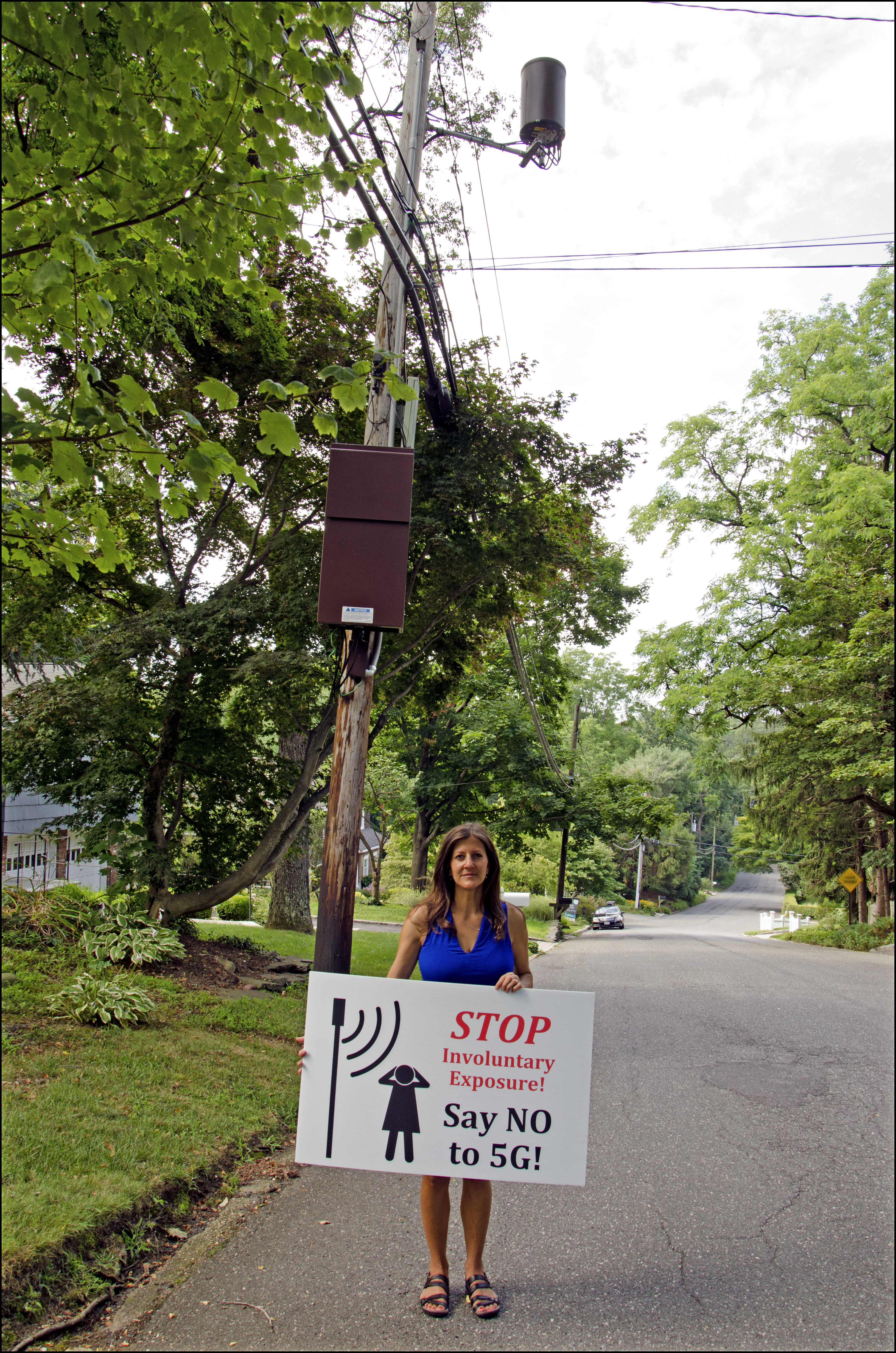By Dave Paone
Campus News
Marie F. despises anything wireless. She despises cell phones, cordless phones and wireless routers. She despises all of these things because they make her physically sick. And she’s especially terrified of the forthcoming 5G.
Her story began about five years ago when she was jolted out of her sleep by what she describes as a “sharp, electrical surge,” going through her body.
Marie found it difficult sleeping each night and suspected it may have had something to do with an electrical current. She tried changing bedrooms, even sleeping in the bathtub some nights.
She hired someone with a gauss meter, which measures magnetic fields. He found high readings coming into the house from the water main in the basement, which were then transferring into her room via the radiator.
She had technicians from the water and electric utilities take a look and they both assured her everything was fine.
A building biologist recommended hiring a plumber and an electrician to install a dielectric union, which prevents excess electricity from the neighboring houses from coming into hers.
It worked. It wasn’t cheap but it worked. For a while.
Then she started feeling listless, with no energy and “almost paralyzed” when she was in her room.
The culprit was the house’s cordless phone. “I feel that thing damned near killed me,” she said.
At first the family didn’t mind that she unplugged the cordless phone each night. Once she started unplugging it during the day, however, they weren’t so understanding.
“It started a war with my family,” she said. “We went to battle. It was screaming… insults hurled… it was just awful.”
Her family thought it was psychosomatic, meaning the problem was all in her head.
Without her family’s knowledge or approval, she replaced the cordless phone with a hard-wired one. This solved Marie’s health problems… for a while.
Soon, she began getting heart palpitations at night and her legs and feet started tingling. The new culprits were two wireless routers. She begged her family to at least shut them off at night, so she could get some sleep. One was turned off; the other wasn’t.
One winter night Marie slept on the front stoop covered with blankets, in an effort to escape the constant barrage of radiation from the router.
She took to turning it off at night herself, which led to more shouting matches. Then she discovered the wireless printer was contributing to her misery as well. “I felt like I was dying,” Marie said.
At long last the family came to a compromise. The routers and wireless devices would get turned off at night.
Marie has what’s called electrohypersensitivity. According to the World Health Organization, EHS is not a recognized medical diagnosis.
But for people like her, adverse reactions to the specific type of radiation that permeates wireless technology are real.
And that’s the crux of their argument. There are two types of radiation: ionizing and non-ionizing. It’s common knowledge that ionizing radiation is harmful.
X-rays are ionizing. So when you have dental x-rays taken, the hygienist covers your torso with a lead apron (to protect your vital organs) and hides behind a lead-lined wall when she takes the pictures. Long-term exposure to ionizing radiation can be deadly.
It’s been thought that non-ionizing radiation, which is what makes wireless devices work, is not harmful. Marie and a host of others worldwide say that’s just not true.
This is where the battle lines are drawn.
Those opposed to non-ionizing radiation cite the many, international studies conducted by scientists who have no connection to the wireless industry. A majority of them conclude that long-term exposure to wireless devices is harmful and deadly.
In the US, the Federal Communications Commission concludes in a 1999 bulletin, “At relatively low levels of exposure to [radio frequency] radiation… the evidence for production of harmful biological effects is ambiguous and unproven.”
Marie is not buying it. She compares this to the cigarette industry — that the tobacco companies knew for years that cigarettes were harmful to the public’s health yet kept this information suppressed from the populace. She’s confident that the FCC knows of the dangers but the wireless lobby is keeping it from making them known.
According to Joel Moskowitz of UC Berkeley, the wireless industry spends $100 million per year lobbying Congress. He states this in the documentary, “Generation Zapped.”
This technology is not going away. In fact, it’s getting bigger and more ubiquitous, specifically in the form of 5G.

Currently, most wireless devices are powered by 4G, the fourth generation of cellular network technology. The next generation, 5G, is already being rolled out.
On its website, Verizon states, “The 5G future is closer than you think…. We are taking a progressive approach to rolling out 5G….”
Campus News reached out to Verizon for their official response to the claim that non-ionizing radiation is indeed harmful, what they know about cell phone RFs as well as what’s ahead with 5G.
We received a reply from Luke Kopetsky of CTIA, the trade association representing the wireless industry in the US. He sent us a link to the website, WirelessHealthFacts.com, as well as links to three recent articles (all 2019) regarding cell phones, 5G and health.
All four links say essentially the same thing: non-ionizing radiation is safe.
Some people with EHS are also affected by smart meters used for gas and electric billing. Instead of meter readers coming to your house to document how much gas and electricity you’ve used, a smart meter transmits this information wirelessly.
Campus News also reached out public utilities, National Grid and PSEG Long Island, for their official stances on smart meters and non-ionizing radiation but did not receive a reply.
In 2016, the Town of Huntington, Long Island, signed a 10-year contract with Crown Castle, a telecommunications infrastructure company, to line the streets with “small cells,” which are something like little cell phone towers. This is in preparation for the forthcoming 5G.
Once they started dotting the landscape, it didn’t sit well with Debbie Persampire (pictured), a soccer mom and resident of the area. She and about 100 other residents voiced their concerns at a town board meeting.
Debbie has since started the activist group, Citizens for 5G Awareness. She and members of the group have had private meetings with the town board. “They have listened to us,” she said.
But the town has said they feel their hands are tied — that it’s a federal issue — and residents need to fight it on a federal level. Debbie doesn’t completely believe that because other states have passed laws limiting this infrastructure.
Installation of the small cells is perfectly legal because Section 704 of the Telecommunications Act of 1996, signed by President Clinton, states that no health or environmental concern can interfere with the placement of telecom equipment, such as cell towers and antennas.
As a mother of a nine and a 10 year old, Debbie depends on her cell phone to stay connected with her family, especially in the event of an emergency. She depends on and uses wireless technology every day.
But she takes precautions. One simple fix is to keep her phone away from her body. “Every inch makes a difference,” she said.
Carrying her phone in a bag, rather than in a pocket, puts a distance between it and her and that’s enough to help. Cell phones actually state in their legal sections that this is recommended.
Debbie said that one reason why the results of cell phone testing are inaccurate is that phones are tested at a distance from the body, but in real life no one does that.
Another simple fix is to keep her phone in airplane mode when she’s not using it. Airplane mode shuts off the RF radiation.
A third simple fix is to use an air tube headset, which contains a hollow, flexible tube that replaces a wire, thereby reducing RFs. Wireless ear devices, on the other hand, are extremely hazardous, according to the RF naysayers.
Another change was to hardwire everything at home. That means no smart meters and Wi-Fi. Her family still uses computers, but they’re driven by fiber optic cables.
While all these modifications are under her control, she and her group have not yet won the battle over small cells outside their houses.
Where we currently stand is the wireless communication companies, the public utilities and their scientists say wireless technology and 5G are safe. Those suffering from EHS, those with small cells in front of their houses and their scientists say they’re not.
Debbie recalled a recent exchange she had with a college student. She was at a barbecue and was seated next to him. He had a cell phone and placed it over his lower abdomen.
“It was driving me crazy, and I finally said, ‘Do you know there’s a message inside your phone that tells you not to put it on your body?’”
Unaware of this, he gave her his phone and she found the warning in the legal notifications.
According to Debbie, after reading it, he said, “From now on I’m going to keep it on the table next to me, and I’m going to stop sleeping with it next to my head.”
Score one for Debbie.





Comments